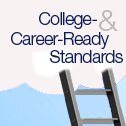High School Principal Damon Smith feels responsible for his graduates beyond the time they leave his building. And he doesn’t want the likelihood of their success in higher education to be a mystery until they take a placement test the fall of their freshman year in college.
At Cambridge Rindge and Latin School in Cambridge, Mass., teachers and counselors look closely at students whose test scores and grades as underclassmen indicate they might not be on track. Then, in 11th or 12th grades they are given the ACCUPLACER tests that community colleges use to gauge readiness for college-level work in math, reading, and writing.

If they don’t pass the placement tests, the school offers an individualized onsite program in partnership with JFYNetWorks, a Boston-based nonprofit, to boost their skills before graduation so they can avoid taking remedial or developmental education courses in college.
“For a while, high school graduation was the threshold, what you are striving for. That no longer can be the goal,” says Smith, whose public school enrolls 1,800 students. About 10 percent of the graduating class each year participates in the intervention program.
Since JFYNet began offering the assessments and blended-learning instruction in the schools four years ago, it has been able to eliminate nearly half of the developmental courses that students would have had to take and save students $1 million in college costs, according to Gary Kaplan, the organization’s executive director.
It’s a small program in 11 high schools in Massachusetts, Maryland, and the District of Columbia, but it was showcased at an event hosted by the Thomas B. Fordham Institute in Washington on Thursday as a model worth pursuing to address the problem of underprepared students entering college.
Fordham President Michael Petrilli highlighted the bleak reality that nearly more than half of community college students start college in need of remedial education. With nearly two-thirds of high school graduates now going directly to college, yet only about one-third college-ready, Petrilli says more needs to be done.
“The notion that there is this group of young people that go to college and only then are told they are not ready is just devastating,” said Petrilli, author the book, Education for Upward Mobility, to be released in December. He believes this type of “pre-medial education” program is an example of a concrete step that high schools can take to signal to students what they need to do before graduation.
Early assessments and corresponding course interventions are gaining traction as part of a concerted push to help students leave high school college-ready.
The college-readiness gap is the single greatest barrier to college completion, maintains Kaplan, and giving the actual ACCUPLACER test in high school provides a clear early picture of what his students need to know before they spend money on tuition.
The cost of the blended-learning program (part online, part in-person instruction) is about $240 per student, per class. Individual schools or districts usually pick up the tab, said Kaplan. While the format is flexible, at Smith’s school, students receive the instruction once a week during a regular math or reading course. After students are assessed, instruction is targeted to address the needed skills, and students are reassessed.
“Do it in high school instead of waiting until they’ve graduated from high school and then suddenly they are hit with bucket of cold water in college,” said Kaplan. “It’s pretty simple, but very effective. If you know that the skills are, teach those skills”
Smith says that while most of his school’s alumni return to share their success in college, some tell him they were not ready. He wants to help all of them succeed: “The goal has to be looking and measuring their life outcomes—how many are employed, getting credentials or being productive member of society.”